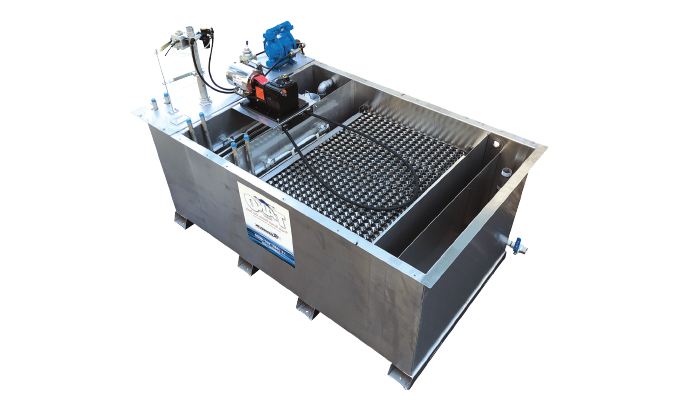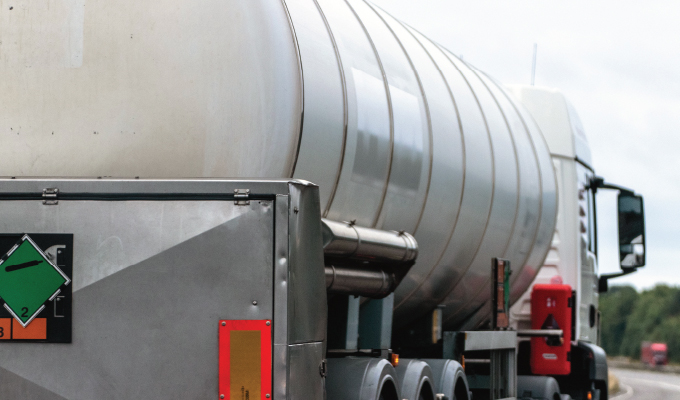By Del Williams
Last month you read about how an oil skimmer using a Free-Floating Connector Tube™ removes floating oil from the surface of wastewater at tank wash facilities. These skimmers work great for customers in the oil transport industry because they are not affected by water level fluctuation or floating debris and solids, remove very little water in the process, and operate continuously with minimal attention or maintenance. However, these skimmers aren’t ideal for every situation. Some more difficult applications require a different method.
OIL WATER SEPARATORS
In more difficult applications when waste oil does not have the time or the space to rise naturally to the surface of the water, there is a need for equipment that will facilitate the separation of oil and water so that the oil can be removed. These conditions typically warrant the installation of an oil and water separator with “coalescing media.” Coalescing media inside a separator accelerates the separation of oil from the wash water by providing additional surface area required for non-emulsified oil droplets to combine, or coalesce, forming larger, more buoyant droplets that can then rise to the surface more quickly and easily.
Conceptually, the physics of an oil water separator are straightforward. Typical separators are designed to achieve separation of oil and water successfully under relatively stable and ideal conditions, such as a consistent flow rate, proper temperature, and relatively low oil concentration. But as a practical matter, the many variables in play in tank wash applications can destabilize the separation process in a typical oil water separator, causing it to perform poorly. Should operating parameters fluctuate from the design parameters of a traditionally designed oil water separator, it can become overwhelmed, resulting in excessive maintenance and, most critically, too much waste oil escaping into the effluent.
SEPARATE & SKIM
A more efficient and cost-effective option today is to install an oil water separator tank with an integrated oil skimmer that provides continuous, active oil removal. Integrating an oil skimmer into the oil water separator design will do more to prevent oil buildup after separation and allow the coalescing media to remain clean. This increases efficiency and minimizes the need for labor, supervision, and maintenance.
An example of such a system involves a Midwest-based, food-grade transportation company, specializing in the bulk transport of edible oils, syrups, milks, and other food products. After a merger with another trucking company expanded its customer base, the tank washing operation quickly became a constraint on growth.
“In our business, tank washing is just as important as the oil transport itself,” explains the company’s plant manager. “The challenges with our tank washing operations were becoming a growing impediment to our growth plans. We needed to clean and turn around our oil carrying trucks faster and more cost effectively.”
The company’s tank truck washing facilities served up to a hundred vehicles daily and involved a process in which a custom hot water spray system was lowered into the tanks through the top hatch.
SAS TANK
To treat the oily water that emerged from the truck cleaning process, the company relied on an oily water separator and the effluent was discharged to a municipal water treatment plant; however, the volume and mix of the truck wash changed, and over time the separator became overburdened with oil. The effluent contained so much residual oil that the treatment plant stopped accepting it. Facing the prospect of incurring costly third-party disposal fees, the firm turned to Oil Skimmers, Inc. for options.
The team at Oil Skimmers, Inc. determined that the tank wash operation had several challenges; among them, the wash process generated periodic spikes in the concentration of oil during the wash cycle. High and fluctuating concentrations of oil are major challenges for typical oil water separators. In addition, the food-grade vegetable oil was often the hydrogenated type that can easily become thick and viscous without adequate heat to flow properly. Because the wash water cooled as it drained, the oil could start to solidify by the time it reached the oil separator tank, clogging the system, slowing treatment, and increasing maintenance requirements.
In response, the Oil Skimmers, Inc. team custom designed a flexible oil water separation “Separate and Skim” SAS Tank™ to meet the plant’s tough operating conditions. Oil Skimmers, Inc.’s SAS Tank oil water separator was equipped with additional features, multiple process stages, and controls to separate and then actively remove oil from the wash water with minimal supervision or maintenance. The system was designed to be capable of efficiently handling peak oily wash water flows in the process, maintaining temperature control and removing the oil from the water actively and continuously, all in a compact size and form factor that fit the space allotted in the shop. The economics more than met shop management’s expectations.

CUSTOM NEEDS
This SAS Tank oil water separator design had three levels of oil removal and separation including advanced capabilities to “knock out” the oil that would have been excessive and overwhelming to more typical oil water separators. An integrated Brill® type oil skimmer with a free-floating collector tube providing continuous, active oil removal completed the final “knock out” of oil. SAS Tanks with these features, delivering at least three levels of oil removal, have come to be known as the TAKO or “Triple Action Knock-out (TAKO)” tanks and have become the standard for tough oil water separator applications.
According to Jim Petrucci, vice president at Oil Skimmers, Inc., both standard SAS Tank oil water separators and TAKO Tanks for tougher applications are capable of featuring a wide range of options and controls. “We can handle the most straightforward or the toughest oil and water separation challenges with as much or little customization as is needed to meet the requirements of the customer’s application.”
While customizing the configuration and options to efficiently remove oil from tank truck wash water today is important, so is working with a partner that can easily make adjustments when circumstances change. As volumes, oil-water ratios, and other factors continue to evolve, adapting and tailoring the oil water separator design to both current and future needs will reliably minimize the cost of compliance as well as labor, operation, and maintenance.
“Whether the application involves just oil skimming or separation of oil and water prior to skimming, it is important to consider all the factors that can be essential to productivity and profitability,” Petrucci concludes.
ABOUT THE AUTHOR
Del Williams is a technical writer who lives in Torrance, California.
Find out more about oil skimmers, oil removal systems, or how to design an oil water separator for your application, visit www.oilskim.com.




